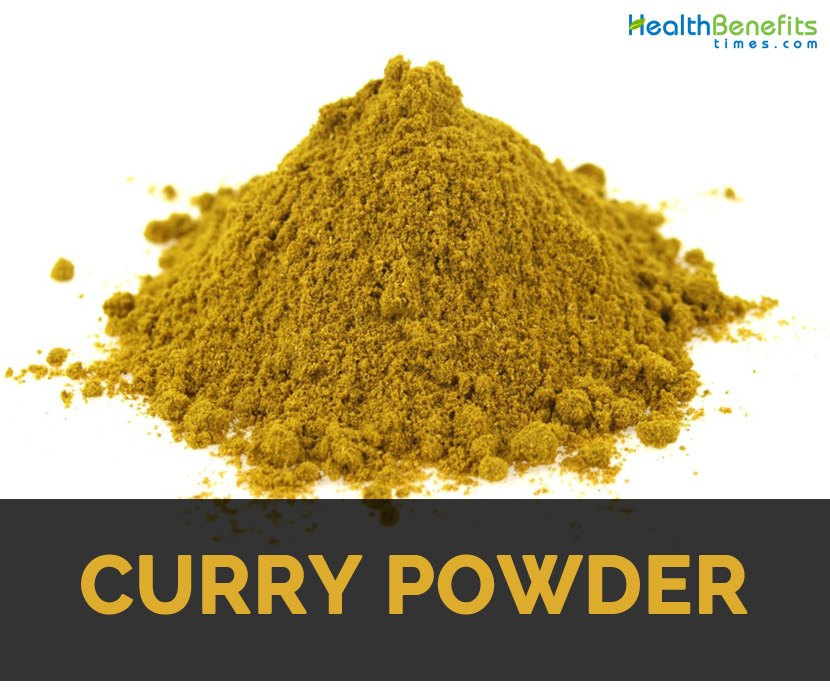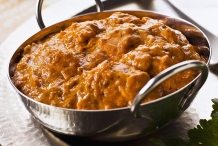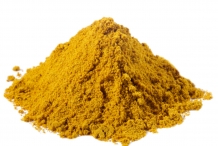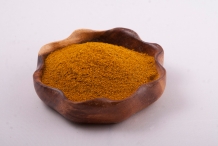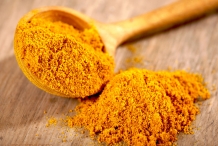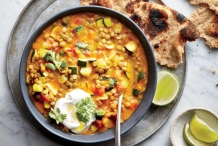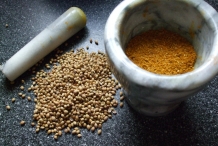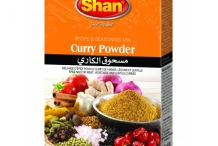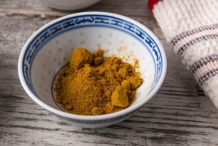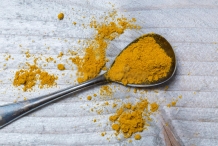| Curry powder Quick Facts |
| Name: |
Curry powder |
| Origin |
Indian subcontinent |
| Colors |
Golden to yellow |
| Taste |
Spicy |
| Calories |
20 Kcal./cup |
| Major nutrients |
Manganese (22.74%)
Iron (15.00%)
Vitamin E (10.60%)
Total dietary Fiber (8.95%)
Copper (8.44%)
|
| Health benefits |
Prevention of Alzheimer’s Disease, Cancer prevention, Lowers inflammation, Cardiovascular health, Bone loss |
Curry powder is the blend of spices used to impart taste and flavor in various culinary uses. The mixture of various spices with various formula and various blends of curry powder are processed to suit various tastes. Curry powder differs from other types of spice mixtures such as rasam powder, sambar powder, pickle masala, chutney powder and garam masala that are used for human consumption. India has been exporting substantial quantities for different spices for long and increase in attention has been concerned in the recent past to exports of curry powder which is the major processed item of spices exported from India.
Traditionally curry powder is related with India that has been reputed as “Home of Spices” and Indian spices are known to be far superior quality. The curry powder is categorized into two types such as ‘mild or sweet’ type and ‘hot’ type which depends on the relative concentration of strong or mild spices. The exotic spices such as cinnamon, cloves, mace, nutmegs and allspice are used in large proportion in mild blends in comparison to hot blends.
This spice is a blend of 20 different spices and herbs such as chiles, cardamom, cloves, cinnamon, fennel, cumin, mace, fenugreek, pepper, nutmeg, sesame seeds, poppy seeds, turmeric, tamarind and saffron. Curry powder is inherent to South Asian cuisines but got popularity in 19th and 20th century to western world due to increase in export of powder as condiment after it was discovered by troops or other colonial visitors to East. Indian cuisine become popular globally in the mid-20th century and curry powder was widely available subsequently.
History
The term curry is derived from “kari” a Tamil world which means ‘sauce, relish for rice’. The blend of spice is found to be used in almost 4000 years ago with basic ingredients like garlic, ginger and turmeric during days of Indus Valley Civilization. Chili pepper is a pervasive ingredient in curry today which was brought from Indian subcontinent through Columbian Exchange in 16th century. After Britain conquered India, curry as introduced to Japan where it was widely known and known as Japanese curry.
Ingredients
Curry powder includes the ingredients such as turmeric, coriander, fenugreek, cumin and chili peppers in blends. The additional ingredients such as garlic, ginger, fennel seed, asafoetida, clove, cinnamon, caraway, green cardamom, mustard seed, nutmeg, black cardamom, curry leaf, white turmeric, black pepper and long pepper depends on the recipe. The import (Portuguese) of chili pepper from Brazil and their combination of other Asian spices allowed the development of curi.
Health Benefits of Curry powder
Curry powder is a predominant ingredient in Indian, Pakistan, South African and Bangladeshi dishes. However, it has become an internationally renowned spice mix. Multiple spices are blended for adding flavor to a dish which was first originated in Pakistan & India. Curry powder is considered to be origin of Eastern. Literally curry powder is a westernized version of spice mix called garam masala which is a part of all Indian and Pakistani dishes. In the Eastern world, curry powder is ground by women themselves but the progress of foods has made the curry powder available packaged and ready to use. According to the brand, the composition and mix varies. Primarily, it is the blend of spices such as cinnamon, nutmeg, turmeric, cinnamon and much more. Packed with different spices, it offers numerous health benefits.
- Prevention of Alzheimer’s Disease
Curry powder includes turmeric as a valuable spice component and turmeric has an organic component known as curcumin. Curcumin helps to lower plaque which free radicals deposit in neural pathways of brain. It vitalizes immune system for eliminating amino acids which makes this plaque and lowers cognitive decline and risk of Alzheimer’s disease. The studies have shown the connection of consuming curry powder with lowering rate of Alzheimer’s disease.
- Cancer prevention
Research has shown that high amount of turmeric helps to stimulate anti-cancer activity in human saliva. On a measurable scale, curcumin should be consumed in supplement form that should be much higher concentration than found in curry powder. Ongoing studies helps to relate consumption of curry powder with lowering chances of cancerous growths or activities in the human body. Curry powder contains turmeric that effectively lowers the chances of colon cancer.
- Lowers inflammation
Turmeric is an agent having positive health in terms of pain, inflammation and rheumatoid arthritis. It possesses anti-inflammatory qualities that lower joint inflammation and associated pain of diseases such as rheumatoid arthritis. Turmeric has effects comparable to ibuprofen but organic solutions are much better than artificial pharmaceuticals.
- Cardiovascular health
Heart disease has become a common and harmful disease which affects human beings. Curry powder has two ingredients such as sweet basil and cardamom that acts as vasodilators. It affects proteins that lower the tension in blood vessels. This results in lowering blood pressure that reduces the risk of cardiovascular conditions such as heart attacks, atherosclerosis and stroke.
- Bone loss
The study was carried out on curry powder and its turmeric content in terms of bone health and osteoporosis. But human testing is in its early stages but the animal testing have shown that turmeric helps to increase the speed of bone regrowth, repair and connectivity by lowering the signs of bone loss by 50%. It is powerful to boost bones particularly when one ages by adding diet rich in essential vitamins and minerals.
- Battle bacterial infections
Curry powder has coriander as a beneficial element which helps to counteract bacterial infections such as E.coli and other damaging intestinal infections. An intake of curry powder helps to promote digestive health system and strengthen immune system for defensing against bacterial agents.
- Maintain liver health
Turmeric has curcumin which helps to maintain liver health. It prevents the expression of certain genes which results in cancer, inflammation and growth of tumor in liver. The animal tests have shown curry powder and curcumin helps to promote liver heath by warding off the risk of excess liver toxicity and liver diseases.
- Maintains gut health
Spices found in curry powder are packed with dietary fiber. Besides its antibacterial properties, it also helps to regulate bowel movements and promote healthy gut as well as digestive system. Overall, it assures to maintain healthy intestinal health. Healthy digestive system ensures the body to remain disease free and proper absorbing of adequate nutrients.
- Slows aging process
Curry power possess antioxidants which helps to prevent oxidative damage of the body inside as well as outside. Curry powder contains turmeric and Vitamin C which helps to slower the aging process and also prevents the appearance of wrinkles.
https://www.youtube.com/watch?v=0HvRjI5re2Q
How to store
It loses its pungency quickly. So keep it in an airtight container for 2 month.
Precautions
- As curry powder is an anti-coagulant so people taking blood thinners should consult the doctor for preventing the chances of excessive bleeding.
- People having preexisting gallbladder conditions might experience irritation to gallbladder with the consumption of curry powder.
- Curry powder might cause side effects if used in excessive amounts such as heartburn, vertigo, excessive sweating, burning sensation in feet and anal burning.
References:
http://journals.sagepub.com/doi/abs/10.1177/0015732515660207?journalCode=ftra
https://en.wikipedia.org/wiki/Curry_powder
https://www.geniuskitchen.com/about/curry-powder-487
https://www.thespicehouse.com/spices/curry-powder
https://articles.mercola.com/sites/articles/archive/2016/09/19/curry-spices.aspx
https://www.spicesinc.com/p-3832-all-about-curry-powders.aspx
https://www.organicfacts.net/health-benefits/herbs-and-spices/health-benefits-of-curry-powder.html
https://www.naturalfoodseries.com/11-benefits-curry-powder/
Comments
comments


